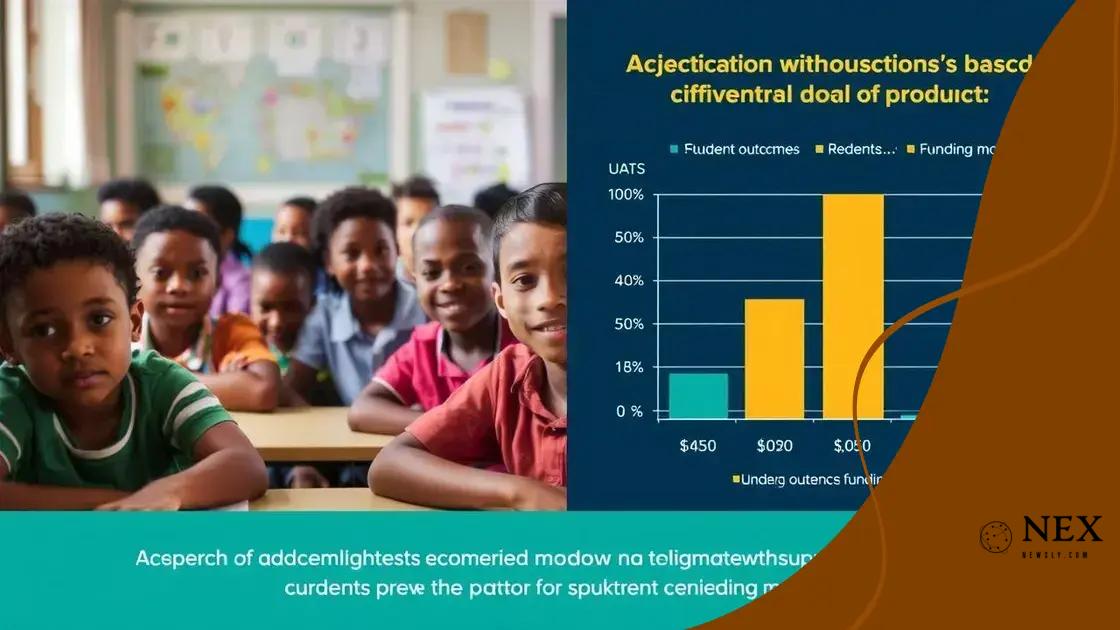Debates over public vs. private school funding: What you need to know

Anúncios
Debates over public vs. private school funding highlight significant differences in resources, student outcomes, and teacher salaries, making community involvement crucial for advocating equitable educational practices.
Debates over public vs. private school funding often spark intense discussions among parents, educators, and policymakers. Have you ever considered how these funding differences affect our children’s education? Let’s dive into this complex issue.
Anúncios
Understanding public school funding
Understanding public school funding is essential in the discussions of educational quality and equity. Schools rely heavily on funding to provide necessary resources, facilities, and opportunities for students.
What is Public School Funding?
Public school funding comes mainly from three sources: federal, state, and local governments. Each plays a crucial role in the budget of a school.
Sources of Public School Funding
- Federal Funding: This is a small portion of the total funding and often comes with specific requirements for use.
- State Funding: States provide the bulk of funding, which is often distributed based on local economic conditions.
- Local Funding: Typically generated from property taxes, this can create disparities between affluent and less affluent areas.
When assessing the impact of public school funding, it’s important to recognize that schools in wealthier neighborhoods usually receive more funding than those in poorer districts. This can lead to a significant difference in educational offerings, extracurricular activities, and overall student outcomes.
Anúncios
Furthermore, disparities can affect teacher salaries and the quality of education. Schools with adequate funding often have better-trained teachers, more advanced courses, and up-to-date technology. This can create a cycle where well-funded schools attract families, while underfunded schools struggle to keep students enrolled.
The Importance of Equity in School Funding
Equity in public school funding means ensuring that all students have access to high-quality education regardless of their personal circumstances. Advocacy groups emphasize reforming funding formulas so that a child’s zip code does not determine their educational opportunities.
This ongoing debate involves various stakeholders, including parents, educators, and politicians. They all have crucial roles in shaping the policies that govern how schools are funded. Engaging in community discussions can help raise awareness about funding disparities and push for change.
Overall, understanding how public school funding works allows communities to take action toward creating a more equitable educational environment for all students.
The role of private funding in education
The role of private funding in education significantly impacts the way schools operate and provide services. Unlike public funding, which comes from government sources, private funding can provide additional resources that schools desperately need.
Types of Private Funding
Private funding can come from various sources, including grants, donations, and tuition fees. Each type has different implications for schools and their students.
Sources of Private Funding
- Individual Donations: Wealthy individuals may support schools directly through donations, helping fund programs and facilities.
- Corporate Sponsorship: Businesses often contribute money or resources in exchange for visibility, which can enhance a school’s offerings.
- Foundations and Grants: Nonprofit organizations provide funds specifically for educational initiatives, allowing schools to pursue special projects.
Private funding can help alleviate some of the disparities between schools in affluent and underprivileged areas. However, this funding can also raise questions about equity. Schools heavily reliant on private funding may offer better facilities and programs, creating a divide that affects student outcomes.
Additionally, the influence of private entities can steer school priorities. With donors’ interests in mind, some schools may prioritize programs that appeal to those donors rather than focusing on the needs of all students. This can lead to an imbalance in educational offerings and experiences.
The Impact on Student Outcomes
Research indicates that schools with significant private funding often achieve better outcomes. These schools can provide enhanced resources, such as smaller class sizes, advanced technology, and extracurricular activities. Such advantages contribute positively to student performance and engagement.
However, it is crucial to consider whether these benefits reach all students equally. Issues of equity remain prominent in discussions about private funding in education. The challenge lies in balancing private contributions while ensuring that all students receive a quality education.
Comparison of student outcomes in different funding models

The comparison of student outcomes in different funding models is vital for understanding how financial resources impact educational achievement. When we look at diverse funding sources, we can see clear trends that highlight disparities among schools.
Public vs. Private Funding
In general, schools funded by public resources tend to have different outcomes compared to those relying on private funding. Public schools often face budget constraints, while private schools may have access to more financial support. This difference can lead to various educational experiences for students.
Key Differences in Outcomes
- Access to Resources: Private schools frequently provide advanced technology and smaller class sizes, enhancing individual attention.
- Academic Performance: Studies indicate that students in schools with greater funding tend to perform better on standardized tests.
- Extracurricular Opportunities: More funding often means a wider array of clubs and activities, which can boost student engagement.
Research shows that when states invest in public schools, students may perform better overall. The ability to offer more programs, updated materials, and extracurricular activities directly impacts how well students learn and thrive.
However, it’s essential to recognize that funding alone does not determine success. Other factors, like teacher quality and family support, play crucial roles in student outcomes. Yet, schools with stable funding certainly find it easier to provide robust educational programs that engage students.
Long-Term Implications
The effects of funding disparities extend beyond immediate academic outcomes. Students from well-funded schools often have better access to advanced courses, college preparation resources, and overall academic support. Conversely, those in underfunded environments may struggle to meet basic educational standards.
The path one takes in education can be heavily influenced by these funding models. Understanding how different funding sources shape the educational experience helps communities advocate for better resources, ensuring that all students have a fair chance to succeed.
Impact on teacher salaries and resources
The impact of funding models on teacher salaries and resources is significant in shaping the quality of education. When schools have adequate funding, they can afford to pay teachers competitive salaries, which helps attract and retain high-quality educators.
Funding Sources and Teacher Compensation
Schools that receive more private funding often offer better compensation packages for teachers compared to those that rely solely on public funds. This difference can affect teachers’ job satisfaction and retention rates. Well-paid teachers are more likely to commit to their schools and invest in their students.
The Importance of Resources
- Classroom Supplies: Adequate funding allows schools to provide essential classroom materials, such as textbooks, technology, and lab equipment.
- Professional Development: Schools with better funding can invest in ongoing training for teachers, ensuring they stay updated on teaching strategies and education trends.
- Support Staff: Additional funding can help hire counselors, librarians, and special education staff, which enhances the overall learning environment.
Conversely, schools facing funding shortages often struggle to provide necessary resources. Teachers in these environments may have to spend their own money on supplies, which can lead to frustration and burnout. The lack of resources can hinder effective teaching and limit student engagement.
Moreover, schools with fewer resources might have higher teacher turnover rates. This instability disrupts students’ learning experiences and makes it challenging for teachers to build strong classroom communities. Teachers need time to create lasting relationships with their students to foster a positive educational atmosphere.
Conclusion
Overall, the connection between teacher salaries and resources directly influences the quality of education. Schools with appropriate funding can better support their teachers, leading to improved student outcomes.
Community voices in the funding debate
Community voices in the funding debate play a crucial role in shaping educational policies and ensuring that all students receive the resources they need. When local citizens engage in discussions about school funding, their collective experiences and perspectives can influence significant changes.
The Importance of Community Engagement
Community members, including parents, teachers, and students, bring unique insights to the conversation. They understand the specific needs of their schools and can highlight the challenges faced due to funding disparities. Their input is vital for decision-makers when considering changes to funding models.
Ways Communities Can Voice Their Concerns
- Public Meetings: Town hall meetings provide a platform for community members to express their opinions on school funding and share personal stories.
- Advocacy Groups: Joining or forming advocacy groups can amplify community voices, allowing for organized efforts to push for equitable funding solutions.
- Surveys and Petitions: Gathering data through surveys or petitions helps illustrate community support for specific funding initiatives, making it easier to demand changes from policymakers.
When communities come together, they can create a powerful force capable of influencing education funding policies. For instance, campaigns that mobilize parents and educators have successfully raised awareness about the impacts of funding disparities, encouraging local governments to reassess budget allocations.
Additionally, community involvement fosters transparency and accountability in how educational funds are used. Parents and residents can advocate for better financial oversight, ensuring that resources are being allocated where they are most needed. This engagement helps build trust between schools and the community.
Building Stronger School-Community Connections
Effective communication between schools and communities is essential in the funding debate. Schools that actively involve community members in discussions about their needs create a sense of shared responsibility. This collaborative approach strengthens relationships and instills confidence in the educational system.
Furthermore, when community voices are included in the funding conversation, it leads to a more comprehensive and equitable educational environment for students. By valuing and incorporating these voices, we can work towards fairer funding practices that benefit all learners.
In conclusion, the debates surrounding public vs. private school funding highlight the importance of equitable resource distribution for all students. Community voices play a critical role in these discussions, advocating for better funding practices that support quality education. Understanding how different funding sources impact teacher salaries and resources, as well as student outcomes, helps communities push for changes that benefit every learner. By working together, we can create a fair education system that ensures all students have access to the resources they need to succeed.
FAQ – Frequently Asked Questions about Public vs. Private School Funding
How does funding impact student outcomes?
Funding significantly affects student performance, access to resources, and overall educational quality.
What role do community voices play in school funding?
Community voices are crucial for influencing decisions and advocating for equitable funding solutions that meet local needs.
How can schools benefit from private funding?
Private funding can provide additional resources for programs, technology, and teacher salaries, enhancing the educational experience.
What are the challenges of public school funding?
Public schools often face budget constraints and funding disparities that can lead to inequities in resources and opportunities for students.





